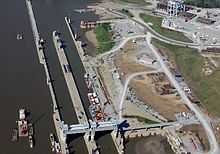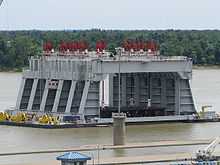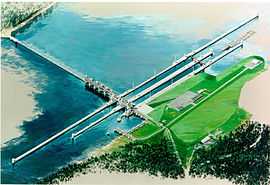Olmsted Locks and Dam
| Olmsted Locks and Dam | |
|---|---|
|
Rendering of Olmsted Locks and Dam. | |
| Location | Pulaski County, Illinois / Ballard County, Kentucky US |
| Coordinates | 37°11′02″N 89°03′49″W / 37.1838°N 89.0635°WCoordinates: 37°11′02″N 89°03′49″W / 37.1838°N 89.0635°W |
| Status | Under construction |
| Construction began | December 1995 |
| Opening date |
2020 (Operational) 2024 (Project Completion) |
| Construction cost | Estimated $2.918 billion |
| Operator(s) | US Army Corps of Engineers |
| Dam and spillways | |
| Impounds | Ohio River |
| Height | 62 feet (19 m) |
| Length | 2,596 feet (791 m) |
The Olmsted Locks and Dam is a locks and concrete dam project currently under construction on the Ohio River, on the border between the U.S. states of Illinois and Kentucky, just east of Olmsted, Illinois. The locks are located at river mile 964.4, below Pittsburgh, Pennsylvania, and about 17 miles upstream from the confluence of the Ohio and Mississippi rivers. The dam will consist of five Tainter gates, a 1,400-foot navigable pass with steel wicket gates, and a fixed weir. The lock chambers, completed in 2002 and located along the Illinois bank, are 110 feet (34 m) wide and 1,200 feet (370 m) long.[1]
According to the US Army Corps of Engineers, the new dam and locks will reduce passage time from 5 hours currently to under 1 hour with the new system.

Evolution of the project
The U.S. Congress authorized spending 775 million dollars to replace two 1920's era Ohio River dams in 1988 with an estimated completion date of 1995; funding was appropriated and released in 1991.[2] The design was performed after July 1997.[2] The latest completion date for the project is 2024 at an estimated cost of 3.1 billion dollars.
Olmsted Locks and Dam replacement project is deemed necessary to allow for the more efficient movement of commerce on the Ohio River. The antiquated design, age and temporary nature of locks and dams 52 and 53 which Olmsted will replace make it impossible to meet traffic demands without significant delays and the U.S. Army Corps of Engineers is replacing these aged facilities with one of the largest civil works projects undertaken by the Corps. The Olmsted Locks and Dam project was authorized by the Water Resources Development Act of 1988. The cost of this project is shared by congressional appropriation and the navigation industry tax on diesel fuel which goes to the Inland Waterways Trust Fund. The fund has been paying 50 percent of the cost, estimated to be $3.1 billion. The project comprises two 110-foot by 1,200-foot lock chambers located along the Illinois shoreline and a dam with five Tainter gates, a navigable pass section and a fixed weir. Construction of the dam The project is being built using several construction contracts; the locks and guide walls are finished, the dam is scheduled for completion in 2020. The Corps of Engineers has been using an innovative method known as “in-the-wet” for the Olmsted Dam. Sections of the dam, called shells, are being fabricated in a casting yard on land, then carried out into the river and set in place. The method has been likened to a child building with LEGOs, only the concrete and re-bar monoliths weigh up to 3,700 tons and are 125x102x30 feet. The underside of a 3,700-ton dam shell project is under construction near the community of Olmsted, Illinois. This stretch provides a connection between the Ohio, Tennessee, Cumberland, and Mississippi rivers and tonnage averages between 80 and 90 million annually – more than any other place in America’s inland navigation system.[3]
Choice of “in-the-wet” construction vs. traditional cofferdam construction methods

"In-the-wet" construction was chosen as an innovation where immense, fabricated dam segments are floated into the flowing river. The traditional cofferdam method, diverts the flow of water and the dam is built on the dry river bed and then the cofferdam is removed and the water flow restored.
Congressional oversight
In 1987, the Corps formally recommended to Congress that a new dam be built near Olmsted, Ill. It did not say how. A year later, an eager Congress authorized $775 million for the project, with expectations that it would get done in seven years. But with government spending, authorizations and appropriations are separate animals. Money for the project did not start to flow until 1991. Congress apparently didn't require competitive bidding.
"Twin 1,200-foot locks were finished — built with cofferdams. Without a completed dam, they were useless. So corps officials offered the lure of a different type of a contract: a “cost-plus” arrangement in which the contractor is paid for expenses up to a limit along with additional payments to allow for a profit.
In January 2004, the Corps awarded a $564 million contract for the dam alone to a joint venture of Alberici Constructors Inc. of St. Louis and Washington Group International, which later became part of URS Corp.
Alberici and URS have worked together in construction projects around the world. In the Olmsted joint venture, URS is the lead contractor, but Alberici’s chief operating officer, Leroy Stromberg Jr., said the partnership is “close to 50-50.”
Olmsted has meant steady profit for the contractors with basically no investment or risk. Under the cost-plus contract, payments include a share of fee distributions based partly on performance and reimbursement for employee salaries and home office expenses supporting employees on the job. Alberici has enjoyed the added benefit of fabricating steel for the project in St. Louis.
“It’s been a good project. We haven’t lost any money,” Stromberg said.
In the early going, the Corps’s Louisville District realized the difficulty of overseeing such a massive project in which the government had, in effect, become the prime contractor.
Design flaws became apparent. The plan called for moving the enormous dam segments on what amounted to 120-square-foot sleds. But the sleds wouldn’t uniformly support the shells and could damage them. So the Corps devised a lifting method that would require a $9.5 million super-gantry crane. Meanwhile, the assembly site, situated adjacent to an old kitty litter plant, needed vast excavation after an earth slide on the slope leading down to the river.
Two years into the contract, the estimated cost had grown by $200 million and nothing had been built.
In-the-wet poses many challenges, none greater than a short construction season on the river — from June 30 through November. Unanticipated high water can further shorten the water construction season, as it did again this summer. At least half the time in recent years, a turbulent river has shortened the season.
The Corps’s chosen method required elaborate equipment that the government now owns: a $19 million, football field-wide catamaran to float the segments; a $17.5 million “aquadigger” for dredging; and a $4 million cradle system to move dam segments to water.
Engineers had to devise a 40-foot-wide curtain made up of heavy chain to protect divers from the current.
Asked what will become of all the specialized equipment after the dam is completed, a Corps official replied: “That’s a good question.”
The Olmsted problem isn’t just water over the dam, as the saying goes. "Keeping the project afloat has drained the Inland Waterways Trust Fund, the account fed equally by shippers and taxpayers to pay for construction on the nation’s marine transportation system."[2]
Lack of feedback from The Inland Waterways Users Board
During a meeting with the Army Corps of Engineers in 2012 The Inland Waterways Users Board had an opportunity to direct the completion of the project be done with the tried-and-true cofferdam method. They chose not to.
Both the June 6th Board Meeting No. 66 held in Pittsburgh and the August 29th Board Meeting No.67 held in St. Louis devoted significant attention to the question of how best from an engineering and technical perspective to complete construction of the project. The main point of discussion at both Board meetings, but particularly at the Pittsburgh meeting, was whether completing the dam feature of the project using the currently employed “In-the-Wet” (ITW)construction method was the best going - forward strategy or, alternatively, whether the Olmsted project should be completed using traditional cofferdam - based “In-the-Dry” (ITD) construction method. The Board’s understanding of the two different options was informed by the May 31, 2012 assessment of the Olmsted “In-The-Wet” compared to “In-The-Dry” construction methodologies that the Corps Great Lakes and Ohio River Division conducted to explore the matter. Board members had and, in some cases continue to have, questions about some of the assumptions that were made and conclusions reached in the ITW versus ITD assessment. Nonetheless, after much discussion and deliberation, the Board did not feel that it was in a position from a technical pers- pective to reject the Corps recommendation to support continued construction of the Olmsted dam using the ITW approach. We understand the Corps reached the 6 critical time for a decision and decided to continue ITW. The Board wonders if a better decision could have been reached if there had been a period of sustained and frank interaction between the Board and the Corps on this pending decision during the time the Board was in hiatus.[4]
The Army Corps of Engineers approach to the project
"In April 2002, Paul Hanley, a Corps official from the Great Lakes and Ohio River Division, announced at a meeting of the Inland Waterways Users Board in Chattanooga that the Olmsted project was “moving along very nicely,” according to minutes of the gathering.
Daniel Steiner, chief of planning in the Corps’s Great Lakes-Ohio River Division, displayed the fervor in the Corps’s underlying innovation, remarking that “navigation modernization is God’s work.”
“We are totally committed to building everything that makes any sense at all in-the-wet,” he said.
But the project quickly ran into trouble. The Corps received no bids from contractors because, as Army engineers confessed later to the navigation industry, of “the perceived risk associated with a new in-the-wet river construction technique.”
“In retrospect, that should have been bells and whistles and red flags to tell the world that this would be a problem,” said John Doyle, a lawyer in Washington for river shippers."[5]
Impact of the delays and cost overruns on other projects
The locks and dam system of the waterways in the U.S. is very old and in great need of replacement and upgrade. The impact of the Olmsted locks and dam project overrun is a delay in the improvement of the whole system of inland waterway commerce.
"The Board is increasingly concerned about the worsening condition of critically important locks and dams on our nation’s waterways and about the growing inability of our current inland waterways modernization program to adequately address this situation. Previous annual reports of the Board have attempted to serve as a clarion call for policy makers to understand and come to grips with this growing investment challenge. Although there are some hopeful signs of increased government recognition of the need to reform the nation’s inland waterways modernization program, it is also clear that conditions continue to deteriorate. We cannot continue to operate much longer under today’s broken model for delivering capital waterways infrastructure projects and expect the system to continue to adequately provide its vital services to our economy.
"Construction of the Olmsted Locks and Dam project continues to illustrate the severity of the problem. Authorized by Congress in 1988 at a then estimated total project cost of $775 million, Olmsted’s estimated project cost had grown to $2.1 billion by the time the Board’s 24th Annual Report was submitted in October 2010. In April 2012 , the Administration announced that the Olmsted project’s cost had increased yet again, to $2.918 billion on a fully funded basis or $3.099 billion based on the project’s expected construction schedule.
"With only approximately half of the project’s needed funding appropriated to date, the new escalated project cost has moved Olmsted’s projected project completion date to September 2024, almost 12 years into the future from today. On a focused, project specific basis, this is a travesty. Worse than a project focused travesty, however, it constitutes a programmatic travesty. The September 2024 completion date is premised on an assumption of $150 million in annual expenditures on the project until Olmsted has been completed. Under status quo policy and practice, only approximately $170 million is expected to be available each year for all inland waterways modernization projects, which means that almost no other priority projects can be funded until after 2024. Olmsted, under the current broken model, essentially stops progress on the rest of the national program for more than another decade." [6]
...In correctly concluding that “the system is not sustainable”, the Regional Business Director of the Corps Great Lakes and Ohio River Division reported to the Board at Meeting No. 66 in Pittsburgh that “At the current funding level of $150 million per year, it will take until 2024 to finish Olmsted, 2033 to finish Lower Mon locks and dams, and 2040 to finish Kentucky Lock.” Chickamauga Lock wasn’t even mentioned in that completely unsatisfactory projection. To make matters worse, during this 30 plus year period, no other new lock and dam modernization project will be able to be constructed under the current program because of insufficient funds in the Inland Waterways Trust Fund. A solution must be found for the project specific and programmatic problems being posed by the Olmsted project."[7]
See also
References
- ↑ "Olmsted Locks and Dam - Project Description". U.S. Army Corps of Engineers. Retrieved 1 November 2013.
- ↑ 2.0 2.1 2.2 Lambrecht, Bill (16 September 2013). "Costly Dam, Illinois dam costing billions more than expected as delays mount". St. Louis Post Dispatch. Retrieved 9 March 2014.
- ↑ "Olmsted Locks and Dam". Retrieved 13 April 2014.
- ↑ "Inland Waterways Users Board 25 Annual Report". 2012. pp. 5–6. Retrieved 12 April 2014.
- ↑ Lambrecht, Bill (16 September 2013). "Costly Dam, Illinois dam costing billions more than expected as delays mount". St. Louis Post-Dispatch. Retrieved 9 March 2014.
- ↑ "Inland Waterways Users Board 25 Annual Report". 2012. p. 3. Retrieved 19 April 2014.
- ↑ "Inland Waterways Users Board 25th Annual Report". Retrieved 12 April 2014.
External links
- Olmsted Locks and Dam project on the USACE website
- Olmsted Locks and Dam locality map
- "From precast yard to river bed" video on YouTube
- Olmsted Dam Construction on Flickr
